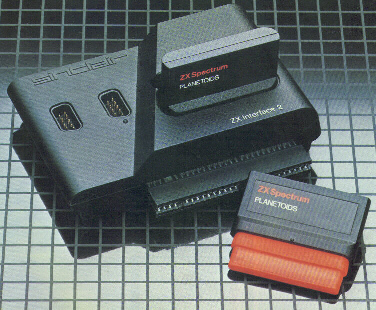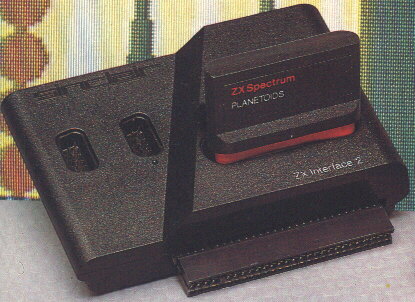Sinclair
Interface II
The following articles were taken
from Sinclair User - December 1983

NEWS
Hard
on the heels of the Microdrive, Sinclair Research
launched its interface 2 at the end of September. Billed
as a peripheral for beginners and experts, it costs
£19.95 and allows Spectrum owners to load cartridge
software and use any joystick with a nine way D plug. At
£14.95, the cartridges are not cheap but Sinclair
Research claims they are fast and easy to load. Because
the whole program is stored on the cartridge, leaving the
computer RAM unused, any program will run on a 16k
machine even if it was written originally for 48k.
The cartridges already available include games like Space
Raiders, Cookie, Hungry Horace and Jetpac, as well as
Chess and Backgammon. True to form, Sinclair Research is
offering the Interface 2 for sale by mail order only in
the early stages. "The response has been good so
far," says a company spokesman, "but it is too
early
to say how sales will develop. We cannot predict when
Interface 2 will be available in the shops."
REVIEW
Sinclair has just announced the Interface 2,
which has followed the Interface 1 within a few
weeks.Interface 2 provides two joystick sockets, which
take standard Atari joysticks and a ROM cartridge slot.
The joystick ports are non-standard, as the only software
to work with them is from Sinclair or Psion.
They operate the number keys only and each joystick
operates the first or last set of numbers. Despite the
advertisements there is no software built into Interface
2 - only a ULA to act as a port for the joysticks. The
ROM cartridge socket is also a disappointment, as it
provides no special switching to page ROM's in and out.
The cartridge has all 16 address lines and eight data
lines on it but, because of the way Sinclair designed the
Spectrum, none of the internal memory can be switched
off, so the only programs which can be provided can be
16k long versions which will replace the Basic ROM.
They are available by turning-off the power, plugging in
the cartridge and turning on the power. The games then
auto-start. An interesting point is that Sinclair has
saved money by having the bare silicon chip wired direct
to the PCB instead of mounting inside the normal IC
casing. A printer connection is provided at the back of
the unit to run the Sinclair printer only. That is
because none of the other connections is connected. It
would seem that Sinclair has produced its last peripheral
for the Spectrum.
At £19.9 for Interface 2 and £14.95 for each ROM
cartridge, they may not be in great demand unnless the
price is reduced dramatically. The joysticksare also out
of step with software manufacturers who program games to
work with the Kempston-type joystick interfaces. Sinclair
Research is the only company selling Interface 2.
The following review was taken from
Personel Computer News October 1983
Plug in and go . . .

Instantaneous
loadings now a reality for Spectrum owners, with the
release of Interface 2, which provides a joystick
interface and ROM cartridge port for the machine.
Its arrival comes as something of a surprise - it was
launched quietly in late September, bang on schedule, and
users waiting for the Microdrives, courtesy of Interface
1 are currently being invited to buy Interface 2 before
they've even had so much as a sniff of Interface 1.
Stocks of the new interface are apparently large enough
for it to be readily available, although Microdrives are
still in very short supply.
Interface
2 plugs neatly into the back of the Spectrum - or, for
the lucky few, into the back of Interface 1 - and
provides two major advantages for the machine. First, ROM
cartridges can be used, so all you need do is power up
for your program to be ready and loaded, and second, it
will accept two standard Atari-type D-plug joysticks.
Sinclair Research emphasises that these can be any type
of joystick with a 9-way D-plug, and that, as the
necessary software is built into Interface 2, the
joysticks will work with cassette-loaded programs as well
as ROM cartridges. Ten of the most popular Spectrum games
are already available on cartridge.
Interface
2 is currently being sold by mail order for £19.95, and
the ROM cartridges are selling for £14.95 - cheap for
what they are, but still something of a blow for those
used to cheap games tapes.
The Spectrum was initially conceived by Sinclair as a
low-cost hobbyists micro - it did the job it set out to
do well, at a very competitive price. But it was still
something of a bare bones machine - many of the
facilities needed to communicate adequately with the
outside world were left out of the design. Users were
therefore left with just the cassette interface, and with
a cheap, but poor quality, printer.
Bit by
bit, companies like Kempston filled the gap - it became
possible to use joysticks and decent printers, although
there were still compatibility problems. Not all games
would operate with a given joystick. and vice versa.
Therefore, although some excellent games have been
produced for the Spectrum, it hasn't always been possible
to play them the way they should be played. And if you
were reduced to playing through the keyboard alone, you'd
have even more problems because of the poor response from
the cut-price keys.
Construction
With Interface 2, these problems are starting to fade.
The device itself is finished in the standard Sinclair
Model T black, is slightly wider than the Spectrum's edge
connector, and slots tidily into said connector. The ROM
cartridge itself slots into a slightly oval socket, which
is protected by a sort of hatch affair, and the joystick
ports are situated to the left of this.
It is a prime example of the growing petite-ness of
Sinclair Research products.
But in operation, it's more than just a pretty case.
Setting aside for the moment the ROM cartridge facility,
which will allow you to load programs which would
otherwise be simply too big for the Spectrum, the
joystick interface alone promises to give the market a
thorough shaking up, for a number of reasons.
First, there is the advantage of standardisation. The
Kempston set-up had already gone some way to achieving
this, like Interface 2, the Kempston interface plugs into
the edge connector, and uses standard D-plug joysticks.
and the com-pany has been having some considerable
success in persuading software producers to include
joystick code routines in their games programs.
But this has in no way been a universal solution to the
problem. Many of the Spectrum owners most willing to
spend money on a joystick interface must already be
confirmed games addicts, and so will have at least a
handful of games which were, until now, incompatible with
joysticks of any description.
You could use the Pickard Joystick Controller, which is
wired up in such a way that it fools the computer into
thinking that you are sending it the key codes it
expects, but it is a fiddly operation to fit, and is not
particularly warranty-friendly.
Interface 2 gets round this rather stylishly, and simply
because it comes from the machine's manufacturer, it is
assured of the position of the industry standard.
Sinclair
hasn't made the support bracket, featured on the
Interface I part of the package. This bracket screws on
to both the Spectrum case and interface 1 to form a solid
connection with the Spectrum board and reduces the
dreaded RAM-wobble problem prevalent on the ZX81.
The connection has a tendency to wear down leading to
frequent crashes and the omission here is particularly
unfortunate considering the unavoidable amount of stress
and strain likely to be placed on the Interface 2 as
cartridges and joysticks are plugged in and out.
Visually,
the nicest thing about the product is the cartridge
itself. True to form, Sinclair has done a marvellous
miniaturisation job, producing cartridges about 1.5 x 2 x
0.3 inches.
At £14.95 Sinclair is producing some of the cheapest
games cartridges on the market although they now look
decidedly overpriced following Commodore's recent
decision to cut its games cartridges for the Vic 20 to
around the £10 mark. There was some talk from Sinclair
before the launch to the effect that £16 would be the
price for its cartridges although it may be that the
price will come down after a few months.
Another nifty feature is the red rubber skirt which
envelops and protects the cartridge connector when it is
not plugged into the games port. When the cartridge is
plugged in, the skirt is pulled up out of the way.
There's a hinged lid over the games port and a pair of
plastic plugs to protect the joystick sockets. These are
easily remov-able - and also easy to lose, although
Sinclair says they can be dispensed with anyway.
In use
As with all cartridge systems the power must be off when
the cartridge is inserted or removed from the port. On
the Atari this restriction is made idiot-proof by the
access lid to
the cartridge cavity switching off the power to the
computer when it is opened.
Unfortunately no such safeguards are featured with
Interface 2, though the law of probability says you will
commit this crime at least once during the lifetime of
the system.
The accompanying
literature is sketchy but adequate, telling you how to
program the joysticks for you own games in Basic or
machine Code.
The codes follow the top row of the keyboard: ten keys
equal up, down, left, right and fire for each of two
joysticks and these can be read from Basic using the IN
function.
All the cartridges can be
used with either a 16K or 48K Spectrum because your not
using much of the RAM memory in any case. You can use the
interface and joysticks with cassette games as well and,
according to Sinclair the games produced over the past
year already have the routines for joystick control
included.
Sinclair wont commit itself to when the interface and
cartridges will make an appearance in the shops alongside
the cassette tapes. It will depend on demaid which so far
has been encouraging.
Verdict
The Interface 2 is a neat little product. Its priced
about right and Sinclair obviously hopes to make a big
killing in the run-up to Christmas. It would be a much
better product if the cartridges were priced at £10
instead of £15.
|
